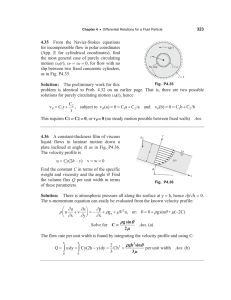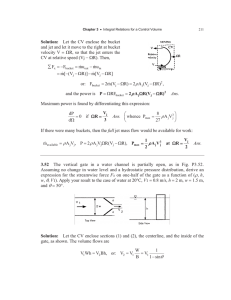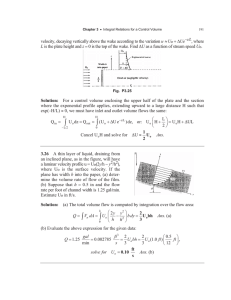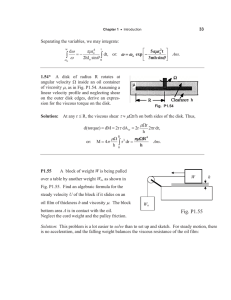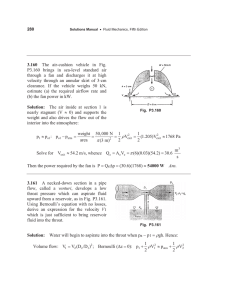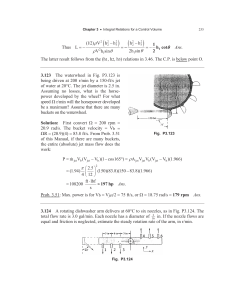U S
advertisement
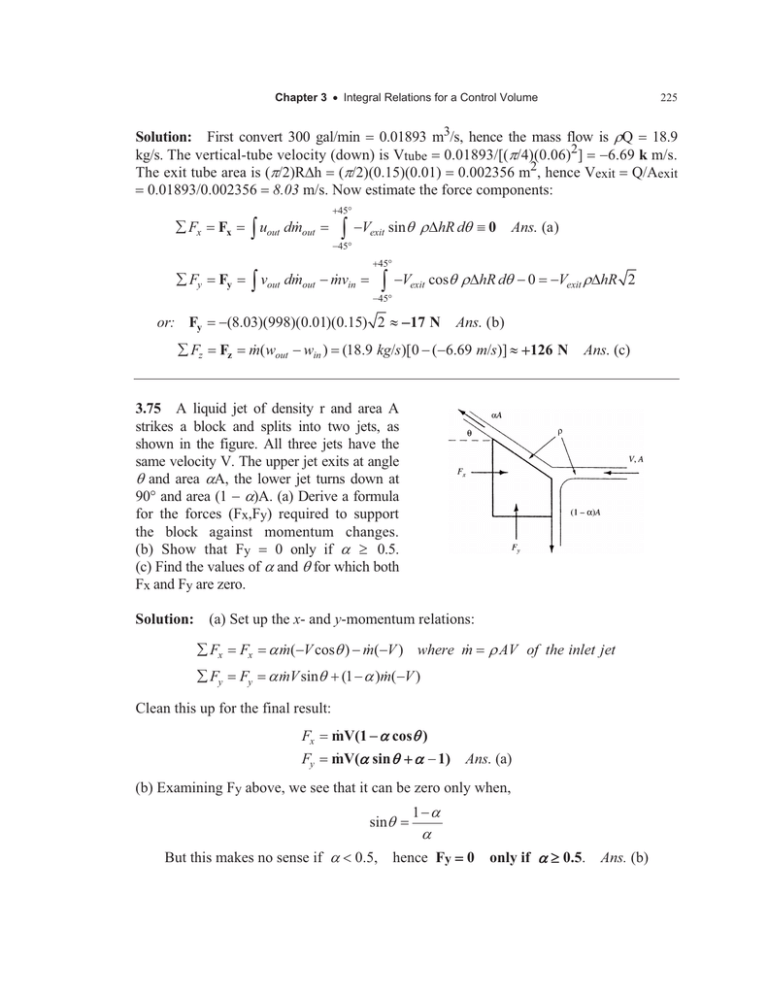
Chapter 3 x Integral Relations for a Control Volume
225
Solution: First convert 300 gal/min 0.01893 m3/s, hence the mass flow is UQ 18.9
kg/s. The vertical-tube velocity (down) is Vtube 0.01893/[(S/4)(0.06)2] 6.69 k m/s.
The exit tube area is (S/2)R'h (S/2)(0.15)(0.01) 0.002356 m2, hence Vexit Q/Aexit
0.01893/0.002356 8.03 m/s. Now estimate the force components:
¦ Fx
¦ Fy
or: Fy
¦ Fz
Fx
Fy
³ uout dm out
³
45q
³
Vexit sinT U'hR dT { 0
in
vout dm out mv
45q
³
Vexit cosT U'hR dT 0
Vexit U'hR 2
45q
(8.03)(998)(0.01)(0.15) 2 | 17 N
Fz
Ans. (a)
45q
Ans. (b)
m (wout win ) (18.9 kg/s)[0 (6.69 m/s)] | 126 N
Ans. (c)
3.75 A liquid jet of density r and area A
strikes a block and splits into two jets, as
shown in the figure. All three jets have the
same velocity V. The upper jet exits at angle
T and area DA, the lower jet turns down at
90° and area (1 D)A. (a) Derive a formula
for the forces (Fx,Fy) required to support
the block against momentum changes.
0 only if D t 0.5.
(b) Show that Fy
(c) Find the values of D and T for which both
Fx and Fy are zero.
Solution: (a) Set up the x- and y-momentum relations:
¦ Fx
Fx
D m (V cosT ) m (V ) where m
¦ Fy
Fy
sinT (1 D )m (V )
D mV
U AV of the inlet jet
Clean this up for the final result:
Fx
Fy
mV(1
D cosT )
D sin T D 1) Ans. (a)
mV(
(b) Examining Fy above, we see that it can be zero only when,
sinT
But this makes no sense if D 0.5,
1D
D
hence Fy 0 only if D t 0.5.
Ans. (b)
226
Solutions Manual x Fluid Mechanics, Fifth Edition
(c) Examining Fx, we see that it can be zero only if cosT 1/Dwhich makes no sense
unless D 1, T 0°. This situation also makes Fx 0 above (sinT 0). Therefore the
only scenario for which both forces are zero is the trivial case for which all the flow goes
horizontally across a flat block:
Fx
Fy
0 only if: D
3.76 A two-dimensional sheet of water,
10 cm thick and moving at 7 m/s, strikes a
fixed wall inclined at 20° with respect to
the jet direction. Assuming frictionless flow,
find (a) the normal force on the wall per
meter of depth, and the widths of the sheet
deflected (b) upstream, and (c) downstream
along the wall.
1, T
0q
Ans. (c)
Fig. P3.76
Solution: (a) The force normal to the wall is due to the jet’s momentum,
¦ FN
(b) Assuming V1
A2
(c) Similarly, A3
m inuin
V2
V3
A1 sinT
A1 cosT
(998)(0.1)(72 )(cos 70q) 1670 N / m
Ans.
Vjet, VjA1 VjA2 VjA3 where,
(0.1)(1)(sin 20°) 0.034 m | 3 cm
(0.1)(1)(cos 20°)
0.094 m | 9.4 cm
Ans.
Ans.
3.77 Water at 20°C flows steadily through
a reducing pipe bend, as in Fig. P3.77.
Known conditions are p1 350 kPa, D1
25 cm, V1 2.2 m/s, p2 120 kPa, and D2
8 cm. Neglecting bend and water weight,
estimate the total force which must be
resisted by the flange bolts.
Solution: First establish the mass flow
and exit velocity:
m
kg
§S ·
U1A1V1 998 ¨ ¸ (0.25)2 (2.2) 108
s
©4¹
Fig. P3.77
§S ·
998 ¨ ¸ (0.08)2 V2 , or V2
©4¹
21.5
m
s
